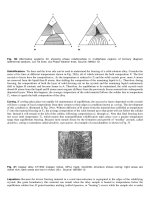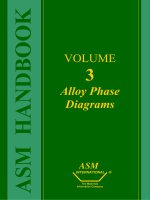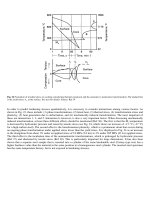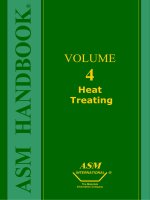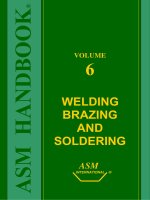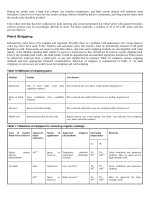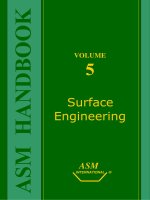ASM Metals HandBook P10
Bạn đang xem bản rút gọn của tài liệu. Xem và tải ngay bản đầy đủ của tài liệu tại đây (60.34 KB, 10 trang )
During the anodic etch, a high acid content, low solution temperature, and high current density will minimize smut
formation. Carryover of water into the anodic etching solution should be held to a minimum, and long transfer times after
the anodic etch should be avoided.
Cold rolled steel that has been subjected to deep drawing and certain prepickled hot rolled steels with glazed brownish-
colored surfaces may be exceedingly difficult to clean. For these materials, a solution of 25 to 85 vol% nitric acid has
proved effective.
Paint Stripping
Infrequently, parts have to be stripped and repainted. Possibly there is a problem with appearance; the wrong paint or
color may have been used. Tools, fixtures, and automatic spray line fixtures must be periodically cleaned of old paint
buildup as well. Some paints are easier to strip than others, and some paint stripping methods are incompatible with some
metals. A hot alkaline cleaning bath, which is a part of a metal process line, should not be used as a paint stripping tank.
Even if the cleaning bath works, the bath quality would be degraded and uncontrolled impurities introduced. Paint cannot
be effectively removed from a soiled part, so any part should first be cleaned. Table 10 compares various stripping
methods and lists appropriate financial considerations. Selection of strippers is summarized in Table 11. In paint
stripping, two processes are widely used, hot stripping and cold stripping.
Table 10 Methods of stripping paint
Method Facility Cost factors
Immersion One or more tanks, water rinse
capability required
Slow removal rate, low labor, costly facility, disposal cost
Spray or brush-
on
Area, ventilation, rinse capability
required
Slow removal rate, higher labor, lesser cost facility, disposal cost
Abrasive Sand or shot blast facility Slow removal, high labor, may use existing facility, disposal cost
Molten salt Specialized facility for steel only Rapid removal rate, costly facility, low labor, very efficient, lower disposal
cost, fume collection required
Table 11 Selection of strippers for removing organic coatings
Operating
temperature
Type of organic
finish to be removed
Approved
metal
substrates
Means of
application
Approved strippers
and methods
°C °F
Remarks
Epoxy primer
epoxies
polyurethanes
All
(a)
Spray or
brush on
Proprietary phenolic
chromated methylene
chloride
10-
38
(b)
50-
100
(b)
Good ventilation and protective
clothing. Must be approved for
high-strength steels
Steel Immersion Low viscosity
(c)
10-
38
(b)
50-
100
(b)
Good ventilation and protective
clothing
All others
All
(a)
Spray or
brush on
High viscosity
(c)
10-
38
(b)
50-
100
(b)
Must be approved for high-
strength steels
All Steel
(d)
Immersion Proprietary molten salt As specified by
vendor
2-5 min follow with water
quench and rinse. Smoke and
fume control required
Primers, wax,
overspray, and
temporary coatings
All Wipe or
squirt on
Butyl cellosolve methyl
isobutyl ketone, ethyl
alcohol xylene, toluene
Room
temperature
(e)
Xylene and toluene are normally
only effective on waxes and
some temporary coatings
All except epoxy
based
All Immersion Caustic stripper 10-
38
(b)
50-
100
(b)
Water base 10-12 pH
All Dry abrasive
blast
MIL-G-5634 Type III Room
temperature
Adjust pressure to part fragility
Chromic acid
solution,360-480 g/L (3-4
lb/gal)
Maximum allowable immersion
time is 15 min. Water rinse parts
as soon as possible on removal
from solution.
Epoxy
Aluminum Immersion
Chromic acid plus nitric
acid solution
74 ±
3
165 ±
5
CrO
3
360-480 g/L (3-4 lb/gal),
HNO
3
5% total volume
All Aluminum Immersion Nitric acid solution 50-
78% HNO
3
34 ±
6
110 ±
10
Maximum allowable immersion
time, 20 min
Note: Heavy metals plus stripping chemicals require appropriate means of disposal to meet EPA regulations.
(a)
Except steel heat treated above 1500 kPa (220 psi).
(b)
Optimum temperature range: 18 to 29 °C (65 to 85 °F).
(c)
Proprietary: phenolic, chromated, methylene chloride.
(d)
Except heat treated steel.
(e)
Do not exceed 32 °C (90 °F)
Hot stripping uses high caustic level and high temperatures. Alkaline paint strippers contain caustic soda, sodium
gluconate, phenols, or cresols. The bath is used at 80 to 95 °C (180 to 200 °F). Depending on the type of paint and coating
thickness, stripping can be done in 30 min to 6 to 8 h. Hot stripping is slow, but economical and environmentally safe.
Hot alkaline paint strippers will attack brass, zinc, and aluminum. These strippers are safe for steel and copper.
Cold stripping, as the name indicates, is done without any heating. The stripping bath consists of powerful organic
solvents, such as methylene chloride; also organic acids, such as phenols or cresols. Many of the organic solvent strippers
available in the market contain two layers. The heavier bottom layer is the organic solvent layer, in which the actual paint
stripping takes place. The lighter top layer is the aqueous layer which prevents the evaporation of the highly volatile
organic solvents from the bottom layer.
Cold solvent stripping, when applicable, is fast. The process, however, is very expensive and waste disposal could be a
problem. Unlike hot strippers, the organic cold strippers can be used on all base metals such as steel, copper, aluminum,
brass, and zinc.
Newer paint stripping technologies strive to combine advantages of both the hot and cold stripping techniques. These
paint strippers, called diphase or multiphase strippers, allow hot alkaline stripping and solvent-based stripping to occur in
the same tank via formation of a stable paint stripping emulsion. The emulsion stripper is best run hot with high agitation
to keep the emulsion stable. This process is often able to strip paint that cannot be stripped by either hot alkaline or cold
solvent methods, and it is comparatively fast.
Glass Bead Cleaning
Glass bead cleaning is a low energy, nonpolluting method for use with both small and delicate parts as well as large
turbines and engines. Glass bead air systems equal or surpass the finish quality provided by liquid abrasive slurry. Other
benefits include no measurable amount of metal removed from close tolerance surfaces (fine threaded screws) and
noncontamination of work surfaces with wide range of bead sizes (170 to 400+ grit). Glass bead cleaning has been
successfully applied to a wide diversity of uses such as: preparation of surfaces for painting, plating, brazing, welding,
bonding; finishing of castings; production of matte finish on metal, glass, and plastics for decorative purposes;
reclamation of tools such as files and saws; stripping of paint; and removal of solder from electrical assemblies.
Air pressures recommended for this procedure range from 70 to 415 kPa (10 to 60 psi). An angle of 40 to 60° for nozzle
to work direction should be used to minimize bounce back and reduce bead consumption because of breakage. The
selection of bead size should be based on the smallest particle that will give the desired surface. This provides the
maximum number of impacts per pound. Working distances of 100 to 200 mm (4 to 8 in.) from nozzle to work will
provide greatest impact (velocity) with the best pattern.
Pollution Control and Resource Recovery
The increasing cost of waste disposal has a great impact on process cost and should be considered in selecting cleaning
processes. Treatment of waste within the plant should be considered to reduce cost, reduce liability, permit reuse of the
raw material, and improve process control. A good example of closed-loop recycling is the distillation purification of
vapor degreasing solvent. The federal EPA has established compliance guidelines, but state and local regulations are often
more stringent. For more information, see the article "Environmental Regulation of Surface Engineering" in this Volume.
Safety
In the use of any metal cleaning process, there are possible safety, health, and fire hazards which need to be considered.
The degree of hazard is dependent upon such factors as the specific materials and chemicals involved, the duration of
employee exposure, and the specific operating procedures.
Information is presented in Table 12 on the types of hazards which may be associated with each cleaning process and the
general control measures which would be used for each hazard.
Table 12 Safety and health hazards of cleaning processes
Cleaning
process
Hazard/air contaminant Control measures OSHA/NFPA
references
Local exhaust ventilation (29 CFR)
Respiratory protection 1910.94(a)
Abrasive
blasting
Silica dust/total dust exposures
Goggles or face shield 1910.95
Cleaning
process
Hazard/air contaminant Control measures OSHA/NFPA
references
Noise exposures 1910.133 Noise exposures
Hearing protective devices 1910.134
1910.1000
Skin abrasion Leather protection garments
Table Z-3
Local exhaust ventilation 1910.94(L)
Respiratory protection 1910.133
Acid gas or mist exposure
Goggles or face shield 1910.134
1910.1000
Acid cleaning
Skin contact Impervious gloves and garments
Table Z-1
Local exhaust ventilation 1910.94(d)
Respiratory protection 1910.133
Alkaline mist exposure
Goggles or face shield 1910.134
1910.1000
Alkaline
cleaning
Skin contact Impervious gloves and garments
Table Z-1
Local exhaust ventilation 1910.94(d) Petroleum or chlorinated
hydrocarbons
Respiratory protection 1910.132
1910.133
1910.134
Emulsion
cleaning
Alkaline mist exposures Local exhaust ventilation
1910.1000
Cleaning
process
Hazard/air contaminant Control measures OSHA/NFPA
references
Tables Z-1, Z-2
Respiratory protection Alkaline mist exposures
Goggles or face shield
Emulsion
cleaning
Skin contact Impervious gloves and garments,
Local exhaust ventilation 1910.94(d)
Respiratory protection 1910.133
Acid gas or mist exposures
Goggles or face shield 1910.134
1910.1000
Pickling
Skin contact Impervious gloves and garments
Table A
Heat resistant gloves and garments 1910.132 Burns
Face shield 1910.133
Local exhaust ventilation 1910.134
1910.1000
Toxic gases
Respiratory protection
Table Z-1
Proper facility design, construction, maintenance
Proper controls for tank
Salt bath
descaling
Fire/explosion
Proper work procedures
NFPA 86C,
Chapter 11
1910.94(d) Solvent
cleaning
Petroleum or chlorinated
hydrocarbon exposure
Local exhaust ventilation
1910.132


